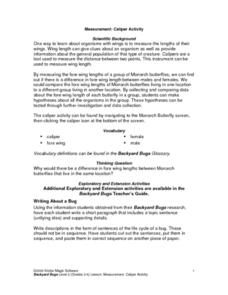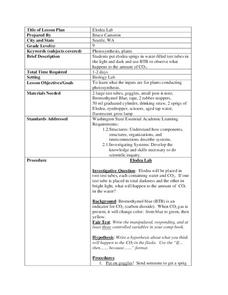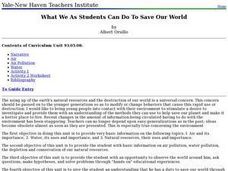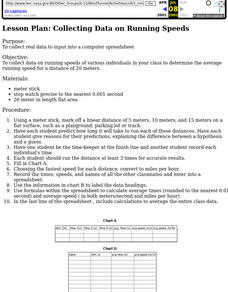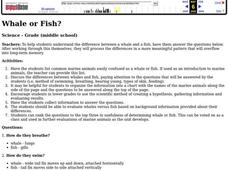Curated OER
Colonizing the Stars
Middle schoolers compare and contrast the size, composition and surface features of the nine planets of our solar system with the possible sizes and compositions of extra -solar planets.
Curated OER
Scientific Theories
Ninth graders compare and contrast how different models can be used to represent scientific understandings. They evaluate the use of data when considering scientific claims. Students debate a variety of socio-scientific issues and the...
Curated OER
Lead Detection
Young scholars hypothesize whether the soil sample may have lead contamination and why. They describe what they see happening with the soil samples and the corresponding swabs. Pupils write a brief description of what they observe as the...
Curated OER
Set the Stage
Learners observe evaporation in a controlled environment. Evaporation is the change of liquid water into water vapor (a gas). The rate of evaporation is determined by many factors such as air temperature and humidity, liquid temperature...
Curated OER
Measurement: Caliper Actitivy
Students participate in an investigation of winged organisms. Working with calipers, students measure the wing span of several butterflies from different areas. After recording their measurements, students use their data to explain...
Curated OER
Towel Testing
Young scholars examine how to design and implement experiments. In this paper towel experiment lesson students test the strength of paper towels.
Curated OER
Sediment Study
Eighth graders study sediment and the factors that effect its distribution. In this sediment study lesson students complete a lab activity on sediment distribution.
Curated OER
Elodea Lab
Students observe the changes between elodea leaves placed in darkness and light. In this life science instructional activity, students experiment to find evidence of photosynthesis in elodea leaves. Students use indicators to detect the...
Curated OER
Allele Frequencies and Sickle Cell Anemia Lab
Students investigate how selective forces like food, predation and diseases affect evolution. In this genetics instructional activity, students use red and white beans to simulate the effect of malaria on allele frequencies. They analyze...
Curated OER
Alka Rockets! An Introduction to Kinetics
Students identify the factors that influence reaction rates. In this chemistry lesson, students design an experiment to test one factor they identified. They perform the experiment and share the results to the entire class.
Curated OER
Our Solar System to Scale
Students calculate the diameter of planets and their relative distances. In this space science lesson plan, students discover how small or big the planets are in comparison to each other. Students use cross multiplying fractions to find...
Curated OER
Soil Sample Lab 2
Students examine each soil sample and record observations. In this biology lesson, students design an experiment to test soil flow rate. They write a lab report about the experiment.
Curated OER
The Scientists’ Way
Students summarize the steps of the scientific method. In this life science lesson, students explain the importance of varying only one variable at a time. They analyze possible flaws in their experiment.
Curated OER
Measurement: When Degrees Matter
Eighth graders record the temperature change of the beakers. In this general science lesson, 8th graders create their own data table for recording observations. They discuss experimental results and cite real life applications.
Curated OER
Hazard Mitigation: Bioterrorism
Learners discuss different ways to spread infectious diseases. In this bioterrorism lesson, students model the rate of smoke emission using CalRoad software. They analyze the effects of airborne release of biological...
Curated OER
What We As Students Can Do To Save Our World
Students investigate air and water pollution, and the conservation of natural resources.
Curated OER
Collecting Data on Running Speeds
Pupils collect data on running speeds of various individuals in class to determine the average running speed for a distance of 20 meters.
Curated OER
Space-Age Experiments
Students evaluate the notion of aging by reviewing some of the studies that occurred on John Glenn's space shuttle mission.
Curated OER
Whale or Fish?
Students explain the difference between a whale and a fish. After working through this themselves, they process the differences in a more meaningful pattern that overflows into long-term memory.
Curated OER
Measuring Aquatic pH
Students apply the scientific method and safety rules to aquatic pH. They test unknown solutions for pH levels.
Curated OER
Feeling Crabby?
Students analyze data to investigate the influence of water depth on size among deep-water crabs. They interpret results from this data, and apply the results regarding appropriate fishery regulations.
Curated OER
Yo-Yos, Tow-Yos and pH, Oh My!
Students explore how hydrothermal vents are formed and where they are located on the ocean floor. They study how scientists use CTDs to locate hydrothermal vents.
Curated OER
Rockets
Students explain the basics of rocketry and explain the relationships between mass, acceleration, and thrust.
Curated OER
Volcanic Wrath
Pupils observe volcanic action using an internet Web site of satellite photographs. Stuents create a portfolio of observable features.
Other popular searches
- Scientific Method Hypothesis
- Writing Hypothesis
- Gaia Hypothesis
- Making a Hypothesis
- Writing a Hypothesis
- Hypothesis Writing Labs
- Creating a Hypothesis
- Origin of Life Hypothesis
- Hypothesis Worksheets
- Practice Writing Hypothesis
- Hypothesis Generation
- Gaea Hypothesis






